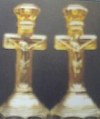Wide Panel Epergne
WIDE PANEL EPERGNE
Surely we will all agree that for dramatic presentation, these satin-like finished epergnes cannot be surpassed! For pattern collectors, the overall appearance places them in the “stretch category”, for they lack a raised and decorative design of note. One must encompass the utility and function of these, in order to fully appreciate their unique beauty. Such appearance is not unique to this epergne. There are a few other items in the stretch line, which carnival glass collectors readily accept.
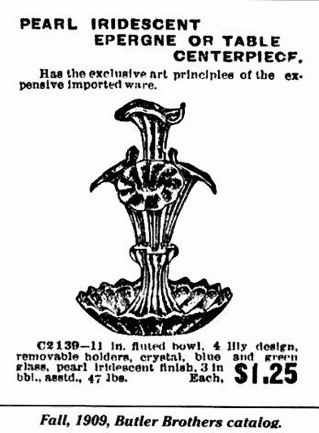 |
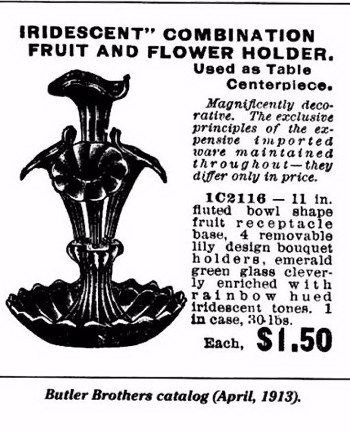 |
First offered for sale by Harry Northwood in the Oct. 1909 Butler Brothers Catalog in “emerald green” glass, marvelously enriched with our favorite rainbow hued iridescent tones. This catalog cut remained unchanged for three years until the epergne was offered in “crystal, blue and green glass (with) pearl iridescent finish.”
It is worth noting that the photos showing the “long neck” on the epergne, appearing in the Butler Brothers Catalogs, remained unchanged throughout the years as design of these epergnes was altered. Engravers costs to create new plates as the changes took place were as significant at that time in history as printing costs of today!
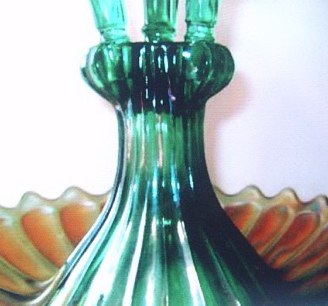 |
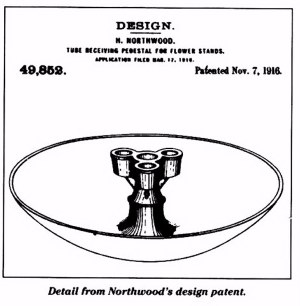 |
Close-up of riser area showing no ring.
|
Patented Stand
|
Since this epergne has no ring on the riser section under the holder area, we must presume it to be the earliest production. The fruit bowl section is 11 ½” across (1/2” more than the later versions.) The overall height is 17”, making it 1” taller than the other epergnes shown in this segment, all of which do have the ring mount.
March 17, 1916, Harry Northwood applied for a patent on the base to hold the lilies. He called it a “tube-receiving pedestal for flower stands”. His patent was granted on November 7, 1916 (patent No. 49,852). Stated on the patent was that widely varying forms of this plain base (pictured in the drawing) may be employed.
Harry Northwood thought enough of his achievement in just the base alone, to patent it for himself. It certainly is a clever piece of work and detail.
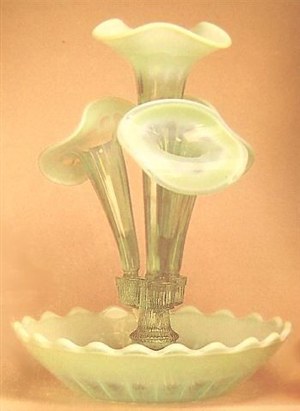 |
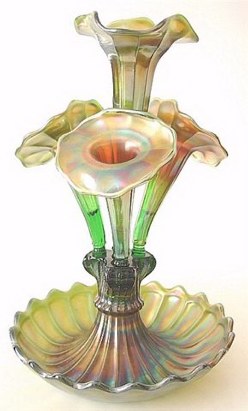 |
Green Opalescent epergne, showing a different lily attachment.
|
Green-The first iridescent offering.
|
Information contained in the Harry Northwood-The Wheeling Years, 1901-1925 compiled by Heacock, Measell, Wiggins states that inspiration for these epergnes surely came from England. This same book also states on pages 126 and 155 that the #710 green opalescent epergne shown here, having differences where the trumpets fit into their holders, WAS ALSO MADE IN MARIGOLD!
First packaged with three (epergnes) to a case, but soon thereafter, they were packaged separately.
Since green was the introductory color, it apparently sold well, for even today, this is the most available color. Marigold, amethyst, blue, white, ice blue, ice green and aqua opal are much sought colors, as well. Of course the pastel examples are extremely scarce and costly. (A very nice marigold epergne having a chip on the side of one lily, recently brought nearly $1800 over Ebay.) Considering the estimated value of an aqua opal epergne at $25,000 or more, a marigold seems very reasonable doesn't it? This epergne is 16” tall, with a bowl diameter of 11”.
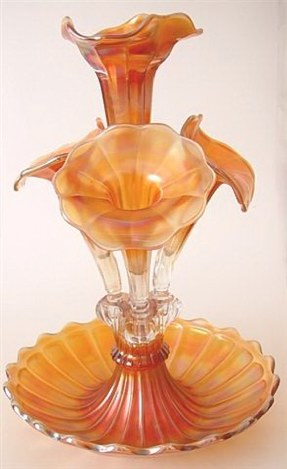 |
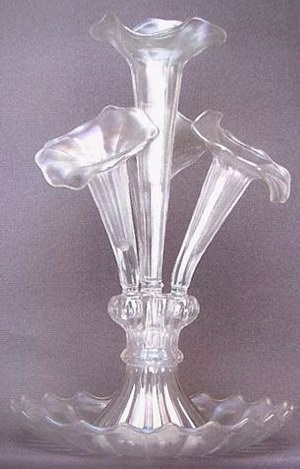 |
Marigold Four Lily Epergne
|
White Epergne
|
The combined purpose of this piece was to hold fruit in the bowl, while sustaining flowers in each of the four lilies. Each lily rests in its own pocket, mounted atop the center mound of the 11” bowl. 21 scallops extend around the outer rim, with each lily having 10 scallops. These also correspond with the number of panels or ribs in each piece. Each of the three side lilies are shaped into the Jack-in-the-Pulpit shape, while the center lily has been crimped three times with each crimp pointing upwards. This seems to be the “standard” shaping for all epergnes. There is an “N” in the recessed center of the base, deep in the column supporting the lilies. It is 16” in height, creating a magnificent treasure.
Damage to these epergnes is quite common for several reasons: 1. Removing the lilies and returning them to their holders would account for much damage to either the base of the lily or the receptacle hole into which each fits. 2. Breaking the entire lily through repeated handling. 3. Breakage on the base receptacle. Just removing this unit from its mold without sustaining some type of damage would have been a major feat.
The original design was sold until at least 1914 and is the only multi-lily epergne made in Carnival Glass.
Note: A marigold epergne having a chip alongside one lily, sold over Ebay recently for nearly $1800.
White is considered a very rare color. We have only seen three or four during our collecting years. $3500 would be a basic price guess for a nice white epergne. Blue would be in the $2500 range. Amethyst would approach the prices of green and marigold, or go for perhaps somewhat more.
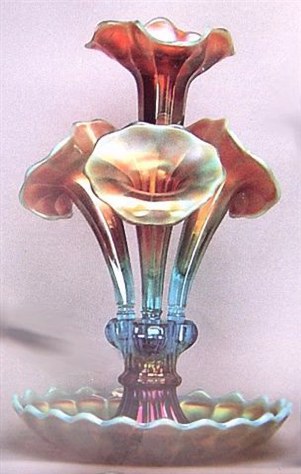 |
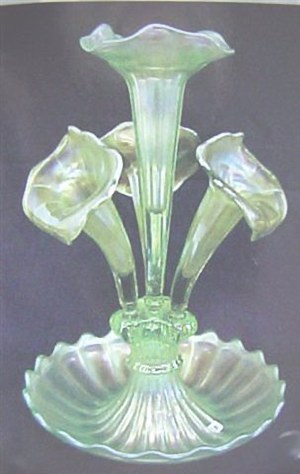 |
Aqua Opal Epergne
|
Ice Green Epergne
|
This is the most valuable and elusive of all colors known in this Epergne. So far as is known, one has not sold at a carnival glass auction during our years of collecting. Basic price for one of these: About $35000.
|
Ice Green and Ice Blue are in the $15,000 range.
|
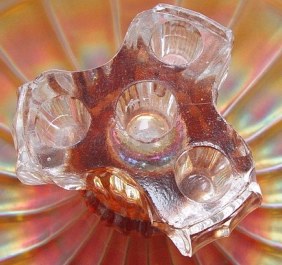 |
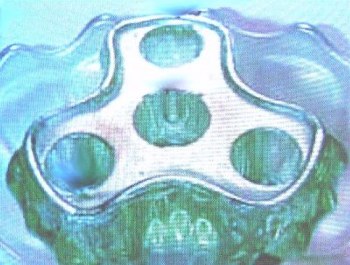 |
The clamp grasped this area while the spraying took place. Therefore, no iridescence is found on this portion of any of the epergnes.
|
Best explanation for this ridge of glass around the area of the lily holes: This was probably of early manufacture prior to having
trouble with the mold.
|
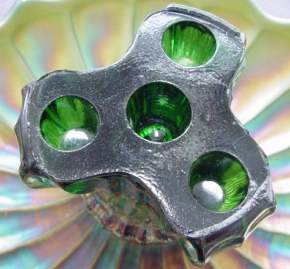 |
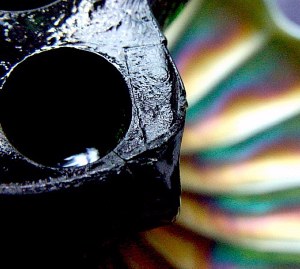 |
A Dutchman repair
|
A Dutchman repair - Close-up
|
Following alteration (repair) of the mold (probably as a result of a weak place in the metal), only the ridge of glass at the outer points is left visible following the repair process. Perhaps this problem led to the invention of the metal bowl and lily holder, which brought about the patent.
|
In carpenter's language, such a patch (repaired area) as this is called a “Dutchman”. If you look closely at that small area, you will see the two screws which held it in place, along the outer edge of the “Dutchman.” Now, you can look at the one(s) on your shelves to see whether you have an earlier or later version.
|
Dean & Diane Fry ~~2/04

Faddish lives age quickly.
“Anchor yourself to the great “I AM”,
and you will develop more and more into a person who is ageless,
whole, true, and at rest.”
~~”Disciples of the Heart” by Anne Ortlund

Should you care to contact the Frys, their email address is:
Search Our Sites
back to Carnival Glass 101
Our other sites you may enjoy:
Everything you EVER wanted to know about Indiana Glass
Great Reference for Newer Carnival Glass.
Complete Glassware Catalogs Available to Download
Questions? Comments? Suggestions? Broken Links? Corrections?
Your Friendly Webmaster is here to help!
